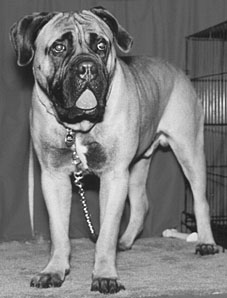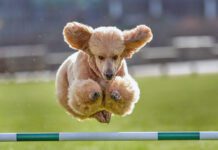Newfoundlands. St. Bernards. Irish Wolfhounds. Great Danes. They are the giants of the canine world, and it takes a special kind of person to appreciate their extra large appeal.
I think of a “big” dog as one whose normal weight exceeds the 100-pound mark. In addition to the above-mentioned breeds, this includes many of the Mastiff-type dogs, the Great Pyrenees, Scottish Deerhound, some (but not all) Rottweilers, and more. The only requirement for membership in this club is size. Everything about them is big, from their appetites (and by-products thereof) to the crates, collars, and other training equipment that they use, as well as the toys that they play with. Pet supply companies offer giant-sized Kongs, tennis balls, tug toys, and just about every other canine accessory you can think of. They know there’s a “big” market out there.

Vet bills can be bigger too, since most surgeries are charged at least in part by the dog’s weight. Larger dogs generally need more anesthesia. Even finding a home can be more of a challenge for big-dog humans. Many landlords and hotels, if they allow animals at all, accept pets who are 25 pounds or less. The next socially acceptable size-increment seems to be around 70 to 75 pounds. Much bigger than that, and non-dog people tend to think you really are some kind of serious dog-nut, to want to share your life and home with a dog who outweighs many of the family members. Much to the consternation of big-dog humans, many of the giant breeds are listed on insurance company “do not insure” lists, making it almost impossible for some big-dog owners to find homeowners or renters insurance.
Finally, sadly, many of the giant breeds tend to have short life spans; a 10-year-old Great Dane is pretty ancient, while lots of 10-year-old small dogs are still in excellent condition and can look forward to 5 to 10 more years of life.
The big challenge
The awe-inspiring size of these dogs presents their human companions with a long list of training and management challenges not encountered by keepers of smaller dogs. Some are simple logistical challenges. Exactly how big a vehicle do you have to have to accommodate a couple of Great Dane crates? We could be talking motor home here, just to run to the local training class! Not to mention the extra space you need in your master bedroom if you plan to crate a few Newfies in your personal den. And imagine the ease with which a Wolfhound’s tail can clear a coffee table, or swipe expensive porcelain statuettes from their display shelves.
Everything we have said in the past about prevention through management and training goes triple for big dogs. Teaching good manners when your wee one is a mere 15 to 20 pounds at age 10 weeks gives you a huge advantage over those who wait until 12 months, by which time the untrained, out-of-control, 150-pound Presa Canario may already be gearing up to maul an innocent neighbor. These dogs’ forbidding size demands an early course in juvenile good manners. While your visiting aunt may be willing to tolerate the petite pawprints of a Pomeranian on her pantsuit, she is likely to frown on plate-sized mud-covered Wolfhound feet on the front of her cashmere sweater.
Socialization is another critically vital part of a large dog’s educational experience. Many giant breeds have strongly developed guarding instincts. A poorly socialized, poorly trained large dog is a significant risk to the safety of the community. A well-socialized and trained dog will be able to turn on his protection behaviors if needed, but no matter his size, will be safe to have around your friends and family. A poorly socialized small dog is just as sad a statement about pet-owner irresponsibility as an unsocialized large dog, but is less of a risk to the community; a kamikaze Chihuahua can do far less damage on his worst day than a scud missile Neapolitan Mastiff on a minor bender.
Tall training tips
There are a number of good manners behaviors that are particularly important to teach your large dog while she is still small. Pay special attention to these if you have a big dog:
Polite Greeting: As mentioned above, jumping up to greet humans is rude behavior for any canine, and especially intolerable for a large dog. Start when your baby giant is small by avoiding the temptation to pick her up and cuddle her. (Cuddling teaches her that “up” is a very wonderful place to be.) Instead, designate a spot on the floor as “Cuddle Space,” and get down on her level to do snuggle time. Teach “Sit” as a greeting/default behavior by consistently and generously rewarding your puppy for sitting, and turning away and stepping away anytime she jumps up. Insist that family members, visitors, and people on the street greet her only when she is sitting politely.
Loose Leash Walking: If you begin teaching polite leash walking to your young pup, you will never find yourself being skijored down the street behind your Rottie as she takes off after an unexpected skateboarder. The keys to teaching good leash walking are a high rate of reinforcement (lots of Clicks! and treats) and very high-value treats, so that it is more rewarding for your dog to pay attention to you than her surroundings (see “Loose Leash Walking,” WDJ November 2000). If you’ve already missed out on teaching this while your pup is small, consider using a head halter to maintain gentle control of your big dog while you retrain her leash behavior (see “Head Halters, Right and Wrong,” WDJ June 2000).
Say Please: Also known as “No Free Lunch” or “Nothing in Life is Free,” a “Say Please” program teaches your dog to ask for all good things in life by offering a sit in order to get what she wants. This prevents her from learning that she can push people around by virtue of her sheer weight and size. You can initially train and ask for the sit behavior, but your ultimate goal is for your dog to offer sits without being asked (see “Sit Happens,” WDJ February 2001). If she is allowed on the furniture, she sits and waits to be invited, rather than just helping herself to the empty space on the sofa next to your visitor. Want to go outside? “Sit” makes the door open. Ready for dinner? “Sit” makes the dinner bowl descend to the floor.
Down: A big-dog lover myself, I don’t understand why some people don’t fully appreciate the joy of having a Newfoundland drool in their laps, but it’s a fact – some just don’t. A big dog is still plenty accessible for an occasional pat on the head if she is lying at your visitor’s feet instead of panting in his face.
Teach your dog that “lying at feet” is a highly rewardable behavior. Give her attention and treats on a variable schedule (sometimes close together, sometimes with longer pauses in between) when she lies down quietly. Give your guests a container full of treats and instruct them to reward the dog on a random schedule, too. Be sure to ignore any demand behavior, such as whining or barking, so the dog learns that the only behavior that gets rewarded is calm “lying at feet.”
Off/Leave It: It stands to reason that giant breeds have easier access to food-bearing surfaces such as tables and kitchen counters. One chance encounter with a roast beef sandwich can turn a dog into a dedicated counter-surfer. In addition to managing your big dog so she never has the opportunity to learn to counter surf, a well-installed “Off” or “Leave It” cue, which tells the dog to back away from whatever she is looking at, can avert disaster when she has that “Mine!” gleam in her eye and is closer to the holiday turkey than you are (see “Off-Limits,” WDJ January 2002).
Sharing With Others: Like so many other things, resource guarding by a large dog can be infinitely more disastrous than the same behavior presented by her smaller counterparts. When your pup is small, teach her that having humans approach when she is eating or otherwise occupied with a high-value possession makes more great stuff happen. When she is eating from her food bowl, occasionally approach and drop a few exquisite goodies into it. Before long she will want people to be around when she is eating (see “Thanks for Sharing,” WDJ September 2001). Caution: If you already have a serious resource guarding challenge with your dog, big or small, you will want to find a positive trainer/behavior specialist to help you modify this dangerous behavior problem.)
Go To Your Spot: A useful behavior for all dogs, this one is especially helpful when you have guests who don’t appreciate super-sized canines. By repeatedly luring your dog to her “spot” or using targeting to send her to it, you can program a gentle “Go to your spot” cue that tells her to go lie down in her corner. If you use a portable throw rug to mark her “spot” you can take it with you – to the dining room during meals, the den for videos, even to your friends’ houses when you and your big dog go visiting.
Give: The last thing you want to do is get into an argument with a big dog over something she has in her mouth. Take the time to teach your dog “Give” by trading for treats.
Most people make the mistake of only taking “forbidden objects” away from their dogs, which can teach the dog to object, since she learns that she’ll never get it back. If you practice “Give” as a regular training exercise with a “legal” toy or chew object, you can repeatedly return the object in question after the dog gives it up for a treat. This way, she learns that she gets two rewards – the first for giving up the valuable object, the second when she gets the valuable object back again. Then, if she occasionally has to give up an “illegal” object that you can’t return to her, it won’t outweigh the positive impact of all the two-reward trades you have done with her.
Bite Inhibition: Dogs bite. It’s a natural canine behavior. Chances are that at some time in your dog’s life, she may feel compelled to bite. If and when that happens, good bite inhibition could make the difference between a dent in the skin and plastic surgery. It could also determine whether your dog lives or dies, since dogs who bite and cause serious injury tend not to live long – especially big dogs who bite.
You can instill good bite inhibition in a pup by gradually diminishing the force of her bite rather than punishing all bites. A puppy naturally learns to control the force of her teeth through playing with her siblings. If she bites softly, without causing undue pain, the other puppies will keep playing with her. If she bites too hard, the pup she is biting may yelp and run away, refusing to re-engaging in play for a time.
You can do the same thing. If your giant puppy bites softly, continue playing with her. If she bites hard enough to cause pain, give a high-pitched “Ouch!” or “Oops!” and walk away from her. After a short time, begin playing with her again. She will learn to control her bite so that the fun can continue without interruption.
Think Positive: If you think it’s a good idea to force confrontations with your large dog, think again. First, it’s not necessary, and second, the bigger the dog gets, the more likely you are to lose. In old-fashioned force-based training, owners were advised to dominate their dogs, and if the dogs offered to fight back, increase the level of human aggression until the dogs submitted. Dogs who refused to submit were labeled “vicious” and “incorrigible,” and euthanized.
It takes two to fight. If you train with positive methods, you never set the dog up for conflict, and you teach her to willingly and happily respond to your behavior requests because good things happen when she does.
Big bother?
If big dogs are such a challenge, why even bother with them? Some people like the look and feel of a big, solid dog by their sides. Many of these folks don’t consider a canine to be a real dog unless they are at least 75 pounds. There is something very comforting about the bulk of an impressively large canine, especially if you alone in a remote location, traveling through an unsavory part of town, or taking your dog for a late night walk in Central Park.
There is also much to be said for big-dog personalities. As a general rule, they are calmer than many of their smaller brethren – it’s a lot of work to haul around that much bulk. Besides – a St. Bernard-sized dog with a Jack Russell Terrier’s energy level probably wouldn’t be around long – who could live with that?
If you want to think big, by all means go for it. Big rewards go along with those big challenges. Just be sure you are ready for the extra large responsibilities that go along with sharing your home and your heart with a supersized canine.
Also With This Article
Click here to view “Going Big”





